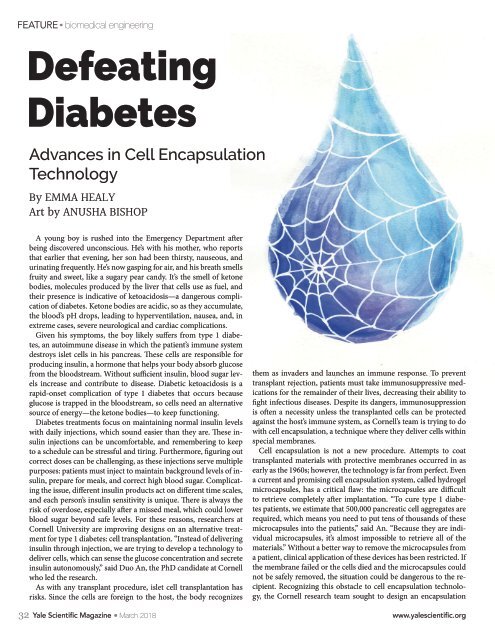YSM Issue 91.1
Create successful ePaper yourself
Turn your PDF publications into a flip-book with our unique Google optimized e-Paper software.
FEATURE biomedical engineering<br />
Defeating<br />
Diabetes<br />
Advances in Cell Encapsulation<br />
Technology<br />
By EMMA HEALY<br />
Art by ANUSHA BISHOP<br />
A young boy is rushed into the Emergency Department after<br />
being discovered unconscious. He’s with his mother, who reports<br />
that earlier that evening, her son had been thirsty, nauseous, and<br />
urinating frequently. He’s now gasping for air, and his breath smells<br />
fruity and sweet, like a sugary pear candy. It’s the smell of ketone<br />
bodies, molecules produced by the liver that cells use as fuel, and<br />
their presence is indicative of ketoacidosis—a dangerous complication<br />
of diabetes. Ketone bodies are acidic, so as they accumulate,<br />
the blood’s pH drops, leading to hyperventilation, nausea, and, in<br />
extreme cases, severe neurological and cardiac complications.<br />
Given his symptoms, the boy likely suffers from type 1 diabetes,<br />
an autoimmune disease in which the patient’s immune system<br />
destroys islet cells in his pancreas. These cells are responsible for<br />
producing insulin, a hormone that helps your body absorb glucose<br />
from the bloodstream. Without sufficient insulin, blood sugar levels<br />
increase and contribute to disease. Diabetic ketoacidosis is a<br />
rapid-onset complication of type 1 diabetes that occurs because<br />
glucose is trapped in the bloodstream, so cells need an alternative<br />
source of energy—the ketone bodies—to keep functioning.<br />
Diabetes treatments focus on maintaining normal insulin levels<br />
with daily injections, which sound easier than they are. These insulin<br />
injections can be uncomfortable, and remembering to keep<br />
to a schedule can be stressful and tiring. Furthermore, figuring out<br />
correct doses can be challenging, as these injections serve multiple<br />
purposes: patients must inject to maintain background levels of insulin,<br />
prepare for meals, and correct high blood sugar. Complicating<br />
the issue, different insulin products act on different time scales,<br />
and each person’s insulin sensitivity is unique. There is always the<br />
risk of overdose, especially after a missed meal, which could lower<br />
blood sugar beyond safe levels. For these reasons, researchers at<br />
Cornell University are improving designs on an alternative treatment<br />
for type 1 diabetes: cell transplantation. “Instead of delivering<br />
insulin through injection, we are trying to develop a technology to<br />
deliver cells, which can sense the glucose concentration and secrete<br />
insulin autonomously,” said Duo An, the PhD candidate at Cornell<br />
who led the research.<br />
As with any transplant procedure, islet cell transplantation has<br />
risks. Since the cells are foreign to the host, the body recognizes<br />
them as invaders and launches an immune response. To prevent<br />
transplant rejection, patients must take immunosuppressive medications<br />
for the remainder of their lives, decreasing their ability to<br />
fight infectious diseases. Despite its dangers, immunosuppression<br />
is often a necessity unless the transplanted cells can be protected<br />
against the host’s immune system, as Cornell’s team is trying to do<br />
with cell encapsulation, a technique where they deliver cells within<br />
special membranes.<br />
Cell encapsulation is not a new procedure. Attempts to coat<br />
transplanted materials with protective membranes occurred in as<br />
early as the 1960s; however, the technology is far from perfect. Even<br />
a current and promising cell encapsulation system, called hydrogel<br />
microcapsules, has a critical flaw: the microcapsules are difficult<br />
to retrieve completely after implantation. “To cure type 1 diabetes<br />
patients, we estimate that 500,000 pancreatic cell aggregates are<br />
required, which means you need to put tens of thousands of these<br />
microcapsules into the patients,” said An. “Because they are individual<br />
microcapsules, it’s almost impossible to retrieve all of the<br />
materials.” Without a better way to remove the microcapsules from<br />
a patient, clinical application of these devices has been restricted. If<br />
the membrane failed or the cells died and the microcapsules could<br />
not be safely removed, the situation could be dangerous to the recipient.<br />
Recognizing this obstacle to cell encapsulation technology,<br />
the Cornell research team sought to design an encapsulation<br />
32 Yale Scientific Magazine March 2018 www.yalescientific.org


















